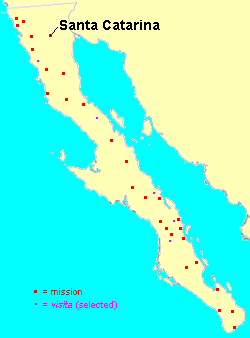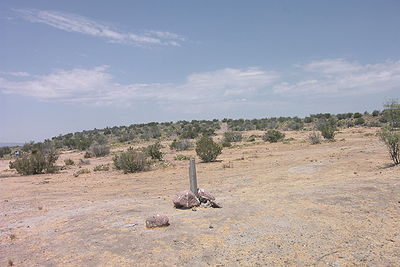
Misión Santa Catarina Virgen y Mártir
Encyclopedia

Mission Santa Catarina was founded on November 12, 1797 in the present-day Valle of El Álamo in the municipio of Ensenada
Ensenada, Baja California
Ensenada is a coastal city in Mexico and the third-largest city in Baja California. It is located south of San Diego on the Baja California Peninsula. The city is locally referred to as La Cenicienta del Pacífico, or, The Cinderella of the Pacific...
, Baja California
Baja California
Baja California officially Estado Libre y Soberano de Baja California is one of the 31 states which, with the Federal District, comprise the 32 Federal Entities of Mexico. It is both the northernmost and westernmost state of Mexico. Before becoming a state in 1953, the area was known as the North...
, México, by the Dominican
Dominican Order
The Order of Preachers , after the 15th century more commonly known as the Dominican Order or Dominicans, is a Catholic religious order founded by Saint Dominic and approved by Pope Honorius III on 22 December 1216 in France...
missionary José Loriente.
The site chosen for the mission lay on a plateau over 1,000 m above sea level, surrounded by an irrigable valley, some 62 km west of Mission Santo Tomás
Misión Santo Tomás de Aquino
Mission Santo Tomás was founded on April 24, 1791 by the Dominican missionary José Loriente, with the authorization of the president of the missions, Juan Crisóstomo Gómez....
. The location was previously known to the native Paipai
Paipai
The Paipai are an aboriginal people of northern Baja California, Mexico. They occupied a territory lying between the Kiliwa on the south and the Kumeyaay and Cocopa on the north, and extending from San Vicente near the Pacific coast nearly to the Colorado River's delta in the east...
as Ha'ketepohol, meaning "water that falls loudly". Following the precedent of Mission San Pedro Mártir
Misión San Pedro Mártir de Verona
Mission San Pedro Mártir was established by the Dominican missionary José Loriente in 1794, in the mountain range of the same name in northern Baja California, Mexico....
, it was the second and last of the Baja California missions to be situated in such mountainous terrain.
Today, Santa Catarina is a village of Paipai and Kumeyaay
Kumeyaay
The Kumeyaay, also known as Tipai-Ipai, Kamia, or formerly Diegueño, are Native American people of the extreme southwestern United States and northwest Mexico. They live in the states of California in the US and Baja California in Mexico. In Spanish, the name is commonly spelled...
Indians, but virtually nothing remains of the original structures. Archaeological investigations of the mission's traces are in progress.
Mission history
The potential mission site was identified in 1794 by a military party led by Sergeant José Manuel Ruiz and accompanied by missionary Tomás Valdellón. In 1796 lieutenant José Joaquín de Arrillaga, a former gobernor (governor) of the Californias, confirmed the suitability of the site.A key factor in the selection of this location was its proximity to the pass of Portezuelo, on a route that led east to the desert and to the Colorado River
Colorado River
The Colorado River , is a river in the Southwestern United States and northwestern Mexico, approximately long, draining a part of the arid regions on the western slope of the Rocky Mountains. The watershed of the Colorado River covers in parts of seven U.S. states and two Mexican states...
. The mission was intended as a defensive fort against eastern intruders as well as a center for converting the local Indians to Christianity.
Physical construction of the Mission complex began on August 6, 1797. By 1812, the administration of the mission had been turned over to the authorities at Mission San Vicente
Misión San Vicente Ferrer
Mission San Vicente was founded in August 1780 by the Dominican missionaries Miguel Hidalgo and Joaquin Valero among the Paipai Indians of northwestern Baja California, Mexico....
. Yet in 1824, the mission was home to 600 neophytes, making it the most populous of the Dominican missions in Baja California at that time.
From the onset, the missionaries had to deal with the theft of cattle and attacks by the locals. In 1840, hostile raiders struck, killing 16 neophytes and burning the mission. Mexican soldiers launched a punitive expedition
Punitive expedition
A punitive expedition is a military journey undertaken to punish a state or any group of persons outside the borders of the punishing state. It is usually undertaken in response to perceived disobedient or morally wrong behavior, but may be also be a covered revenge...
, but the mission was not rebuilt.
Accounts of the mission's demise
An account of the destruction of the mission was given by a Santa Catarina Indian:
A year or two after Fray Félix left for GuadalupeMisión de Nuestra Señora de Guadalupe del NorteMission Guadalupe was founded by the Dominican missionary Félix Caballero in June 1834, at the site of the modern community of Guadalupe, Baja California...
, one September, when most of the people were away from Santa Catalina getting piñon to the northward along the eastern slope of the Sierra Juarez, the Keliwa came and burned the mission. The sacristan and a few old women were there, but they escaped. (A more authentic version states that sixteen of the neophytes were killed in the attack.) Nicuárr, with 500 of his people, pursued the Keliwa into the San Pedro Mártir Sierra and killed most of them (Meigs 1935:122–123).
Still other accounts maintain that the uprising that destroyed the mission included not only the Kiliwa
Kiliwa
The Kiliwa are an aboriginal people of northern Baja California, Mexico. They occupied a territory lying between the Cochimí on the south and the Paipai on the north, and extending from San Felipe on the Gulf of California to San Quintín on the Pacific coast...
but also the Paipai
Paipai
The Paipai are an aboriginal people of northern Baja California, Mexico. They occupied a territory lying between the Kiliwa on the south and the Kumeyaay and Cocopa on the north, and extending from San Vicente near the Pacific coast nearly to the Colorado River's delta in the east...
, Kumeyaay
Kumeyaay
The Kumeyaay, also known as Tipai-Ipai, Kamia, or formerly Diegueño, are Native American people of the extreme southwestern United States and northwest Mexico. They live in the states of California in the US and Baja California in Mexico. In Spanish, the name is commonly spelled...
from La Huerta, and Colorado River groups such as the Quechan
Quechan
The Quechan are a Native American tribe who live on the Fort Yuma Indian Reservation on the lower Colorado River in Arizona and California just north of the border with Mexico...
and Cocopa
Cocopa
The Cocopah or Cocopa are Native American people who live in Baja California and Sonora, Mexico, and in Arizona in the United States. The Cocopah language belongs to the Delta–California branch of the Yuman family. In Spanish, the Cocopah are termed Cucapá...
as well:
They were without a leader in the attack; all fought like animals. They all hated the frailes: the Indians died when the frailes came. They hated the missionaries. (Meigs 1935:123)
Thereafter, the Kiliwa renamed Santa Catarina Wa'iú-ichíu, a combination of the words wa (house), iú (empty), and ichíu (burned).
The Mission compound

Valdellón reported in 1797 that the Santa Catarina capilla (chapel) was constructed of adobe
Adobe
Adobe is a natural building material made from sand, clay, water, and some kind of fibrous or organic material , which the builders shape into bricks using frames and dry in the sun. Adobe buildings are similar to cob and mudbrick buildings. Adobe structures are extremely durable, and account for...
bricks and measured 10 × 5 m, and featured a flat roof; it housed a 150 cm tall statue of Saint Catherine of Alexandria
Catherine of Alexandria
Saint Catherine of Alexandria, also known as Saint Catherine of the Wheel and The Great Martyr Saint Catherine is, according to tradition, a Christian saint and virgin, who was martyred in the early 4th century at the hands of the pagan emperor Maxentius...
. The missionary living quarters measured little more than 25 m², as did the granary. There were also ancillary structures housing three workshops and a women's dormitory, each measuring 5 m square. Additional support buildings were constructed in 1798 and 1799.
As agriculture was fundamental for the subsistence of the site, mission industries consisted mainly of the cultivation of wheat
Wheat
Wheat is a cereal grain, originally from the Levant region of the Near East, but now cultivated worldwide. In 2007 world production of wheat was 607 million tons, making it the third most-produced cereal after maize and rice...
and maize
Maize
Maize known in many English-speaking countries as corn or mielie/mealie, is a grain domesticated by indigenous peoples in Mesoamerica in prehistoric times. The leafy stalk produces ears which contain seeds called kernels. Though technically a grain, maize kernels are used in cooking as a vegetable...
, and the raising and trading of cattle
Cattle
Cattle are the most common type of large domesticated ungulates. They are a prominent modern member of the subfamily Bovinae, are the most widespread species of the genus Bos, and are most commonly classified collectively as Bos primigenius...
, donkey
Donkey
The donkey or ass, Equus africanus asinus, is a domesticated member of the Equidae or horse family. The wild ancestor of the donkey is the African Wild Ass, E...
s, goat
Goat
The domestic goat is a subspecies of goat domesticated from the wild goat of southwest Asia and Eastern Europe. The goat is a member of the Bovidae family and is closely related to the sheep as both are in the goat-antelope subfamily Caprinae. There are over three hundred distinct breeds of...
s, horse
Horse
The horse is one of two extant subspecies of Equus ferus, or the wild horse. It is a single-hooved mammal belonging to the taxonomic family Equidae. The horse has evolved over the past 45 to 55 million years from a small multi-toed creature into the large, single-toed animal of today...
s, mule
Mule
A mule is the offspring of a male donkey and a female horse. Horses and donkeys are different species, with different numbers of chromosomes. Of the two F1 hybrids between these two species, a mule is easier to obtain than a hinny...
s, and sheep.
The nearby rancherías of Agua Caliente, Agua Caliente del Portezuelo, Cerro Colorado, El Portezuelo, El Rincón, La Ciénega, La Huerta, Los Bateques, Poza de González, San Pablo, and Sangre de Cristo were integrated into the Mission holdings.
List of resident padres
The following account of Santa Catarina's resident priests is based on the President of the Missions' nómina sacra, or chart of "sacred names":- 1797–1804 Tomás Valdellón
- 1804–1807 Jacinto Fiol
- 1807–1809 Manuel de Águila
- 1809–1810 Antonio Fernández
- 1810–1811 José Duro
- 1811–1812 Manuel Sáiz
- 1812–1815 no information available
- 1815–1817 Antonio Fernández
- 1817–1819 no information available
- 1819–1839 Félix CaballeroFélix CaballeroFélix Caballero was a Dominican priest. He played an important part in the history of the missions of Baja California.Caballero arrived at Veracruz on December 19, 1812 and traveled to Baja California in July, 1814...

